Computer-generated imagery
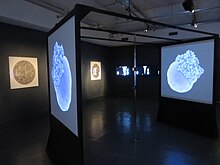
| Three-dimensional (3D) computer graphics |
|---|
 |
| Fundamentals |
| Primary uses |
| Related topics |
Computer-generated imagery(CGI) is a specific-technology or application of computer graphics for creating or improving images inart,printed media,simulators,videos and video games. These images are either static (i.e.still images) or dynamic (i.e. moving images). CGI both refers to 2D computer graphics and (more frequently) 3D computer graphics with the purpose of designing characters,virtual worlds,or scenes andspecial effects(infilms,television programs, commercials, etc.). The application of CGI for creating/improvinganimationsis calledcomputer animation,orCGI animation.
History
[edit]This sectionneeds expansion.You can help byadding to it.(October 2023) |
The first feature film to use CGI as well as the composition of live-action film with CGI wasVertigo,[1]which used abstract computer graphics byJohn Whitneyin the opening credits of the film. The first feature film to make use of CGI with live action in the storyline of the film was the 1973 filmWestworld.[2]Other early films that incorporated CGI includeStar Wars: Episode IV(1977),[2]Tron(1982),Star Trek II: The Wrath of Khan(1982),[2]Golgo 13: The Professional(1983),[3]The Last Starfighter(1984),[4]Young Sherlock Holmes(1985),The Abyss(1989),Terminator 2: Judgement Day(1991),Jurassic Park(1993) andToy Story(1995). The firstmusic videoto use CGI wasWill Powers'Adventures in Success(1983).[5]
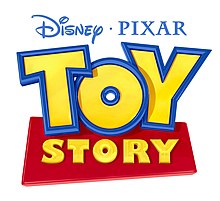
Prior to CGI being prevalent in film, virtual reality, personal computing and gaming, one of the early practical applications of CGI was for aviation and military training, namely theflight simulator.Visual systems developed in flight simulators were also an important precursor to three dimensional computer graphics and Computer Generated Imagery (CGI) systems today. Namely because the object of flight simulation was to reproduce on the ground the behavior of an aircraft in flight. Much of this reproduction had to do with believable visual synthesis that mimicked reality.[6]The Link Digital Image Generator (DIG) by the Singer Company (Singer-Link), was considered one of the worlds first generation CGI systems.[7]It was a real-time, 3D capable, day/dusk/night system that was used by NASA shuttles, for F-111s, Black Hawk and the B-52. Link's Digital Image Generator had architecture to provide a visual system that realistically corresponded with the view of the pilot.[8]The basic archictecture of the DIG and subsequent improvements contained a scene manager followed by geometric processor, video processor and into the display with the end goal of a visual system that processed realistic texture, shading, translucency capabilties, and free of aliasing.[9]
Combined with the need to pair virtual synthesis with military level training requirements, CGI technologies applied in flight simulation were often years ahead of what would have been available in commercial computing or even in high budget film. Early CGI systems could depict only objects consisting of planar polygons. Advances in algorithms and electronics in flight simulator visual systems and CGI in the 1970s and 1980s influenced many technologies still used in modern CGI adding the ability to superimpose texture over the surfaces as well as transition imagery from one level of detail to the next one in a smooth manner.[10]
The evolution of CGI led to the emergence ofvirtual cinematographyin the 1990s, where the vision of thesimulatedcamerais not constrained by the laws of physics. Availability of CGI software and increased computer speeds have allowed individual artists and small companies to produce professional-grade films, games, and fine art from their home computers.
Static images and landscapes
[edit]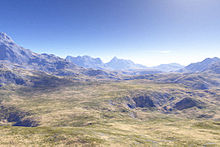
Not only do animated images form part of computer-generated imagery; natural looking landscapes (such asfractal landscapes) are also generated via computeralgorithms.A simple way to generate fractal surfaces is to use an extension of thetriangular meshmethod, relying on the construction of some special case of ade Rham curve,e.g.,midpoint displacement.[11]For instance, the algorithm may start with a large triangle, then recursively zoom in by dividing it into four smallerSierpinski triangles,then interpolate the height of each point from its nearest neighbors.[11]The creation of aBrownian surfacemay be achieved not only by adding noise as new nodes are created but by adding additional noise at multiple levels of the mesh.[11]Thus atopographicalmap with varying levels of height can be created using relatively straightforward fractal algorithms. Some typical, easy-to-program fractals used in CGI are theplasma fractaland the more dramaticfault fractal.[12]
Many specific techniques have been researched and developed to produce highly focused computer-generated effects — e.g., the use of specific models to represent the chemical weathering of stones to model erosion and produce an "aged appearance" for a given stone-based surface.[13]
Architectural scenes
[edit]
Modern architects use services from computer graphic firms to create 3-dimensional models for both customers and builders. These computer generated models can be more accurate than traditional drawings.Architectural animation(which provides animated movies of buildings, rather than interactive images) can also be used to see the possible relationship a building will have in relation to the environment and its surrounding buildings. The processing of architectural spaces without the use of paper and pencil tools is now a widely accepted practice with a number of computer-assisted architectural design systems.[14]
Architectural modeling tools allow an architect to visualize a space and perform "walk-throughs" in an interactive manner, thus providing "interactive environments" both at the urban and building levels.[15]Specific applications in architecture not only include the specification of building structures (such as walls and windows) and walk-throughs but the effects of light and how sunlight will affect a specific design at different times of the day.[16][17]
Architectural modeling tools have now become increasingly internet-based. However, the quality of internet-based systems still lags behind sophisticated in-house modeling systems.[18]
In some applications, computer-generated images are used to "reverse engineer" historical buildings. For instance, a computer-generated reconstruction of the monastery atGeorgenthalin Germany was derived from the ruins of the monastery, yet provides the viewer with a "look and feel" of what the building would have looked like in its day.[19]
Anatomical models
[edit]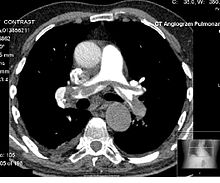
Computer generated models used inskeletal animationare not always anatomically correct. However, organizations such as theScientific Computing and Imaging Institutehave developed anatomically correct computer-based models. Computer generated anatomical models can be used both for instructional and operational purposes. To date, a large body of artist producedmedical imagescontinue to be used by medical students, such as images byFrank H. Netter,e.g.Cardiac images.However, a number of online anatomical models are becoming available.
A single patientX-rayis not a computer generated image, even if digitized. However, in applications which involveCT scansa three-dimensional model is automatically produced from many single-slice x-rays, producing "computer generated image". Applications involvingmagnetic resonance imagingalso bring together a number of "snapshots" (in this case via magnetic pulses) to produce a composite, internal image.
In modern medical applications, patient-specific models are constructed in 'computer assisted surgery'. For instance, in totalknee replacement,the construction of a detailed patient-specific model can be used to carefully plan the surgery.[20]These three-dimensional models are usually extracted from multipleCT scansof the appropriate parts of the patient's own anatomy. Such models can also be used for planningaortic valveimplantations, one of the common procedures for treatingheart disease.Given that the shape, diameter, and position of thecoronaryopenings can vary greatly from patient to patient, the extraction (fromCT scans) of a model that closely resembles a patient's valve anatomy can be highly beneficial in planning the procedure.[21]
Cloth and skin images
[edit]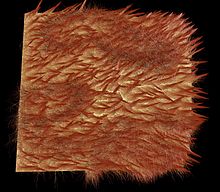
Models of clothgenerally fall into three groups:
- The geometric-mechanical structure atyarncrossing
- The mechanics of continuous elastic sheets
- The geometric macroscopic features of cloth.[22]
To date, making the clothing of a digital character automatically fold in a natural way remains a challenge for many animators.[23]
In addition to their use in film, advertising and other modes of public display, computer generated images of clothing are now routinely used by top fashion design firms.[24]
The challenge in renderinghuman skinimages involves three levels of realism:
- Photo realismin resembling realskinat the static level
- Physical realismin resembling its movements
- Function realismin resembling its response to actions.[25]
The finest visible features such as finewrinklesand skinporesare the size of about 100μmor 0.1millimetres.Skin can be modeled as a 7-dimensionalbidirectional texture function(BTF) or a collection ofbidirectional scattering distribution function(BSDF) over the target's surfaces.
Interactive simulation and visualization
[edit]Interactive visualization is the rendering of data that may vary dynamically and allowing a user to view the data from multiple perspectives. The applications areas may vary significantly, ranging from the visualization of the flow patterns influid dynamicsto specificcomputer aided designapplications.[26]The data rendered may correspond to specific visual scenes that change as the user interacts with the system — e.g. simulators, such asflight simulators,make extensive use of CGI techniques for representing the world.[27]
At the abstract level, an interactive visualization process involves a "data pipeline" in which the raw data is managed and filtered to a form that makes it suitable for rendering. This is often called the"visualization data".The visualization data is then mapped to a "visualization representation" that can be fed to a rendering system. This is usually called a"renderable representation".This representation is then rendered as a displayable image.[27]As the user interacts with the system (e.g. by using joystick controls to change their position within the virtual world) the raw data is fed through the pipeline to create a new rendered image, often making real-time computational efficiency a key consideration in such applications.[27][28]
Computer animation
[edit]While computer-generated images of landscapes may be static,computer animationonly applies to dynamic images that resemble a movie. However, in general, the term computer animation refers to dynamic images that do not allow user interaction, and the termvirtual worldis used for the interactive animated environments.
Computer animation is essentially a digital successor to the art ofstop motionanimation of 3D models and frame-by-frame animation of 2D illustrations. Computer generated animations are more controllable than other more physically based processes, such as constructingminiaturesfor effects shots or hiringextrasfor crowd scenes, and because it allows the creation of images that would not be feasible using any other technology. It can also allow a single graphic artist to produce such content without the use of actors, expensive set pieces, or props.
To create the illusion of movement, an image is displayed on thecomputer screenand repeatedly replaced by a new image which is similar to the previous image, but advanced slightly in the time domain (usually at a rate of 24 or 30 frames/second). This technique is identical to how the illusion of movement is achieved withtelevisionandmotion pictures.
Text-to-image models
[edit]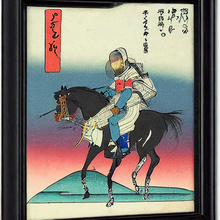
Atext-to-image modelis amachine learning modelwhich takes an inputnatural languagedescription and produces an image matching that description.
Text-to-image models began to be developed in the mid-2010s during the beginnings of theAI boom,as a result of advances indeep neural networks.In 2022, the output of state-of-the-art text-to-image models—such as OpenAI'sDALL-E 2,Google Brain'sImagen,Stability AI'sStable Diffusion,andMidjourney—began to be considered to approach the quality ofreal photographsand human-drawnart.
Text-to-image models are generallylatent diffusion models,which combine alanguage model,which transforms the input text into alatent representation,and agenerative image model,which produces an image conditioned on that representation. The most effective models have generally been trained on massive amounts of image and text datascraped from the web.[29]Virtual worlds
[edit]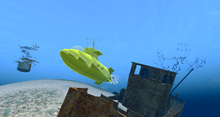
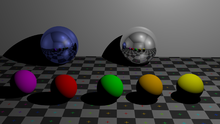
A virtual world is anagent-basedandsimulated environmentallowing users to interact with artificially animated characters (e.gsoftware agent) or with other physical users, through the use ofavatars.Virtual worlds are intended for itsusersto inhabit and interact, and the term today has become largely synonymous with interactive 3D virtual environments, where the users take the form ofavatarsvisible to others graphically.[30]These avatars are usually depicted as textual, two-dimensional, orthree-dimensional graphicalrepresentations, although other forms are possible[31](auditory[32]and touch sensations for example). Some, but not all, virtual worlds allow for multiple users.
In courtrooms
[edit]Computer-generated imagery has been used in courtrooms, primarily since the early 2000s. However, some experts have argued that it is prejudicial. They are used to help judges or the jury to better visualize the sequence of events, evidence or hypothesis.[33]However, a 1997 study showed that people are poor intuitive physicists and easily influenced by computer generated images.[34]Thus it is important that jurors and other legal decision-makers be made aware that such exhibits are merely a representation of one potential sequence of events.
Broadcast and live events
[edit]Weather visualizations were the first application of CGI in television. One of the first companies to offer computer systems for generating weather graphics wasColorGraphics Weather Systemsin 1979 with the "LiveLine", based around anApple IIcomputer, with later models from ColorGraphics usingCromemcocomputers fitted with theirDazzlervideo graphics card.
It has now become common in weather casting to display full motion video of images captured in real-time from multiple cameras and other imaging devices. Coupled with 3D graphics symbols and mapped to a common virtual geospatial model, these animated visualizations constitute the first true application of CGI to TV.
CGI has become common in sports telecasting. Sports and entertainment venues are provided with see-through and overlay content through tracked camera feeds for enhanced viewing by the audience. Examples include the yellow "first down"line seen in television broadcasts ofAmerican footballgames showing the line the offensive team must cross to receive a first down. CGI is also used in association with football and other sporting events to show commercial advertisements overlaid onto the view of the playing area. Sections ofrugbyfields andcricketpitches also display sponsored images. Swimming telecasts often add a line across the lanes to indicate the position of the current record holder as a race proceeds to allow viewers to compare the current race to the best performance. Other examples include hockey puck tracking and annotations of racing car performance[35]and snooker ball trajectories.[36][37]Sometimes CGI on TV with correct alignment to the real world has been referred to asaugmented reality.
Motion capture
[edit]Computer-generated imagery is often used in conjunction withmotion captureto better cover the faults that come with CGI and animation.Computer-generated imagery is limited in its practical application by how realistic it can look. Unrealistic, or badly managed computer-generated imagery can result in theuncanny valleyeffect.[38]This effect refers to the human ability to recognize things that look eerily like humans, but are slightly off. Such ability is a fault with normal computer-generated imagery which, due to the complex anatomy of the human body, can often fail to replicate it perfectly. Artists can use motion capture to get footage of a human performing an action and then replicate it perfectly with computer-generated imagery so that it looks normal.
The lack of anatomically correct digital models contributes to the necessity of motion capture as it is used with computer-generated imagery. Because computer-generated imagery reflects only the outside, or skin, of the object being rendered, it fails to capture the infinitesimally small interactions between interlocking muscle groups used infine motor skillslike speaking. The constant motion of the face as it makes sounds with shaped lips and tongue movement, along with the facial expressions that go along with speaking are difficult to replicate by hand.[39]Motion capture can catch the underlying movement of facial muscles and better replicate the visual that goes along with the audio.
See also
[edit]- 3D modeling
- Cinema Research Corporation
- Cel shading
- Anime Studio
- Animation database
- List of computer-animated films
- Digital image
- Parallel rendering
- Photoshopis the industry standard commercial digital photo editing tool.
- GIMP,aFOSSdigital photo editing application.
- PoserDIY CGI optimized for soft models
- Ray tracing (graphics)
- Real-time computer graphics
- Shader
- Virtual human
- Virtual studio
- Virtual Physiological Human
References
[edit]Citations
[edit]- ^Ozturk, Selen (March 15, 2023)."Vicious Circle: John Whitney and the Military Origins of Early CGI".Bright Lights Film Journal.RetrievedMay 11,2023.
- ^abc"14 groundbreaking movies that took special effects to new levels".Insider.com.
- ^Halverson, Dave (December 2005). "Anime Reviews: The Professional Golgo 13".Play.No. 48. United States of America. p. 92.
- ^"Last Starfighter sequel is super close to happening, says Gary Whitta".Archived fromthe originalon 2021-08-29.Retrieved2021-08-29.
- ^Jankel, A.; Morton, R. (Nov 15, 1984).Creative Computer Graphics.Cambridge University Press. p. 134.ISBN0-521-26251-8.
- ^Rolfe, J. M. and Staples, K.J. (May 27, 1988).Flight Simulation (Cambridge Aerospace Series, Series Number 1).New York: Cambridge University Press.ISBN978-0521357517.
{{cite book}}:CS1 maint: multiple names: authors list (link) - ^Carlson, Wayne (20 June 2017)."Computer Graphics and Animation: A Retrospective Overview".Ohio State University. p. 13.2.
- ^Suminski, Leonard and, Hulin, Paul (September 26, 1980). "Computer Generated Imagery Current Technology".U.S. Army Project Manager for Training Devices:14–18.
{{cite journal}}:CS1 maint: multiple names: authors list (link) - ^Yan, Johnson K. and, Florence, Judit K."MODULAR DIGITAL IMAGE GENERATOR".United States Patent Office.
{{cite web}}:CS1 maint: multiple names: authors list (link) - ^Yan, Johnson (August 1985)."Advances in Computer-Generated Imagery for Flight Simulation".IEEE.5(8): 37–51.doi:10.1109/MCG.1985.276213.S2CID15309937.
- ^abcPeitgen 2004,pp. 462–466.
- ^Game programming gems 2by Mark A. DeLoura 2001ISBN1-58450-054-9page 240[1]
- ^Digital modeling of material appearancebyJulie Dorsey,Holly Rushmeier,François X. Sillion 2007ISBN0-12-221181-2page 217
- ^Sondermann 2008,pp. 8–15.
- ^Interactive environments with open-source software: 3D walkthroughsby Wolfgang Höhl, Wolfgang Höhl, 2008,ISBN3-211-79169-8,pp. 24–29.
- ^"Light: The art of exposure".GarageFarm.2020-11-12.Retrieved2020-11-12.
- ^Advances in Computer and Information Sciences and Engineeringby Tarek Sobh 2008ISBN1-4020-8740-3pages 136-139
- ^Encyclopedia of Multimedia Technology and Networking, Volume 1by Margherita Pagani 2005ISBN1-59140-561-0page 1027
- ^Interac storytelling: First Joint International Conferenceby Ulrike Spierling, Nicolas Szilas 2008ISBN3-540-89424-1pages 114-118
- ^Total Knee Arthroplastyby Johan Bellemans, Michael D. Ries, Jan M.K. Victor 2005ISBN3-540-20242-0pages 241-245
- ^I. Waechter et al.Patient Specific Models for Minimally Invasive Aortic Valve ImplantationinMedical Image Computingand Computer-Assisted Intervention -- MICCAI 2010edited by Tianzi Jiang, 2010ISBN3-642-15704-1pages 526-560
- ^Cloth modeling and animationby Donald House, David E. Breen 2000ISBN1-56881-090-3page 20
- ^Film and photographyby Ian Graham 2003ISBN0-237-52626-3page 21
- ^Designing clothes: culture and organization of the fashion industryby Veronica Manlow 2007ISBN0-7658-0398-4page 213
- ^Handbook of Virtual Humansby Nadia Magnenat-Thalmann and Daniel Thalmann, 2004ISBN0-470-02316-3pages 353-370
- ^Mathematical optimization in computer graphics and visionby Luiz Velho, Paulo Cezar Pinto Carvalho 2008ISBN0-12-715951-7page 177
- ^abcGPU-based interactive visualization techniquesby Daniel Weiskopf 2006ISBN3-540-33262-6pages 1-8
- ^Trends in interactive visualizationby Elena van Zudilova-Seinstra, Tony Adriaansen, Robert Liere 2008ISBN1-84800-268-8pages 1-7
- ^Vincent, James (May 24, 2022)."All these images were generated by Google's latest text-to-image AI".The Verge.Vox Media.RetrievedMay 28,2022.
- ^Cook, A.D. (2009). A case study of the manifestations and significance of social presence in a multi-user virtual environment. MEd Thesis. Availableonline
- ^Biocca & Levy 1995,pp. 40–44.
- ^Begault 1994,p. 212.
- ^Computer-generated images influence trial resultsThe Conversation, 31 October 2013
- ^Kassin, S. M. (1997). "Computer-animated Display and the Jury: Facilitative and Prejudicial Effects".Law and Human Behavior.40(3): 269–281.doi:10.1023/a:1024838715221.S2CID145311101.[2]
- ^Archived atGhostarchiveand theWayback Machine:Arti AR highlights at SRX -- the first sports augmented reality live from a moving car!,14 July 2021,retrieved2021-07-14
- ^Azuma, Ronald;Balliot, Yohan; Behringer, Reinhold; Feiner, Steven; Julier, Simon; MacIntyre, Blair.Recent Advances in Augmented RealityComputers & Graphics,November 2001.
- ^Marlow, Chris.Hey, hockey puck! NHL PrePlay adds a second-screen experience to live games,digitalmediawire27 April 2012.
- ^Palomäki, Jussi; Kunnari, Anton; Drosinou, Marianna; Koverola, Mika; Lehtonen, Noora; Halonen, Juho; Repo, Marko; Laakasuo, Michael (2018-11-01)."Evaluating the replicability of the uncanny valley effect".Heliyon.4(11): e00939.Bibcode:2018Heliy...400939P.doi:10.1016/j.heliyon.2018.e00939.ISSN2405-8440.PMC6260244.PMID30519654.
- ^Pelachaud, Catherine;Steedman, Mark; Badler, Norman (1991-06-01)."Linguistic Issues in Facial Animation".Center for Human Modeling and Simulation(69).
Sources
[edit]- Begault, Durand R. (1994).3-D Sound for Virtual Reality and Multimedia.AP Professional.ISBN978-0-1208-4735-8.
- Biocca, Frank; Levy, Mark R. (1995).Communication in the Age of Virtual Reality.Lawrence Erlbaum Associates.ISBN978-0-8058-1549-8.
- Peitgen, Heinz-Otto; Jürgens, Hartmut; Saupe, Dietmar (2004).Chaos and Fractals: New Frontiers of Science.Springer Science & Business Media.ISBN978-0-387-20229-7.
- Sondermann, Horst (2008).Light Shadow Space: Architectural Rendering with Cinema 4D.Vienna: Springer.ISBN978-3-211-48761-7.
External links
[edit]- A Critical History of Computer Graphics and Animation– a course page atOhio State Universitythat includes all the course materials and extensive supplementary materials (videos, articles, links).
- CG101: A Computer Graphics Industry ReferenceISBN073570046XUnique and personal histories of early computer graphics production, plus a comprehensive foundation of the industry for all reading levels.
- F/X Gods,by Anne Thompson, Wired, February 2005.
- "History Gets A Computer Graphics Make-Over"Tayfun King,Click,BBC World News (2004-11-19)
- NIH Visible Human Gallery
